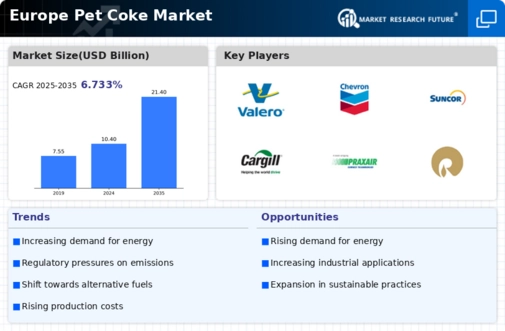Expansion of Cement Production
The pet coke market in Europe is significantly influenced by the expansion of cement production activities. As the construction sector rebounds, cement manufacturers increasingly turn to pet coke as a primary fuel source due to its cost-effectiveness and high energy output. In 2025, it is estimated that the cement industry will account for nearly 30% of the total pet coke consumption in Europe. This shift is largely attributed to the need for sustainable production methods, as pet coke offers a lower carbon footprint compared to other fossil fuels. Consequently, the growth in cement production not only enhances the pet coke market but also aligns with the broader goals of reducing greenhouse gas emissions in Europe.
Shift Towards Alternative Fuels
The pet coke market in Europe is witnessing a shift towards alternative fuels as industries seek to diversify their energy sources. This trend is driven by the increasing pressure to reduce carbon emissions and comply with stringent environmental regulations. In 2025, it is anticipated that the use of pet coke as an alternative fuel will rise by 20% in various sectors, including steel and aluminum production. The pet coke market is likely to benefit from this transition, as manufacturers recognize the advantages of using pet coke over traditional fossil fuels. This shift not only supports sustainability goals but also enhances the competitiveness of European industries in the global market.
Rising Demand for Energy Sources
The pet coke market in Europe experiences a notable increase in demand for energy sources, particularly in the industrial sector. As industries seek cost-effective alternatives to traditional fuels, pet coke emerges as a viable option due to its high calorific value and lower cost compared to coal. In 2025, the energy sector's consumption of pet coke is projected to rise by approximately 15%, driven by the need for efficient energy production. This trend indicates a shift towards utilizing pet coke in power generation and cement manufacturing, thereby bolstering the pet coke market. Furthermore, the growing emphasis on energy security in Europe further propels the demand for pet coke as a reliable energy source.
Technological Innovations in Production
The pet coke market in Europe is positively impacted by technological innovations in production processes. Advances in refining and processing technologies enable manufacturers to produce higher quality pet coke with improved characteristics, such as lower sulfur content. In 2025, it is expected that these innovations will lead to a 15% increase in the overall efficiency of pet coke production. This enhancement not only meets the growing demand for cleaner fuels but also strengthens the pet coke market by attracting new customers. Furthermore, the integration of automation and data analytics in production facilities is likely to optimize operations, reduce costs, and improve product quality, thereby fostering growth in the pet coke market.
Investment in Infrastructure Development
The pet coke market in Europe benefits from substantial investments in infrastructure development. Governments and private entities are channeling funds into various construction projects, which in turn drives the demand for cement and, subsequently, pet coke. In 2025, infrastructure spending in Europe is projected to increase by 10%, creating a favorable environment for the pet coke market. This investment surge is expected to enhance the production capacity of cement plants, leading to a higher consumption of pet coke as a fuel source. Moreover, the focus on modernizing transportation and energy infrastructure further solidifies the role of pet coke in meeting the energy needs of these projects.
























Leave a Comment